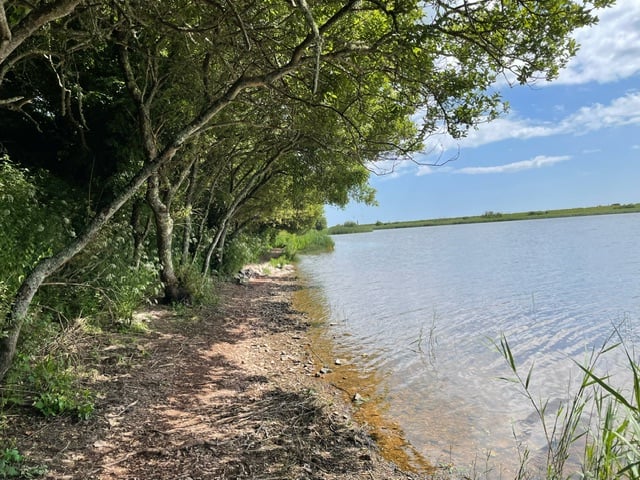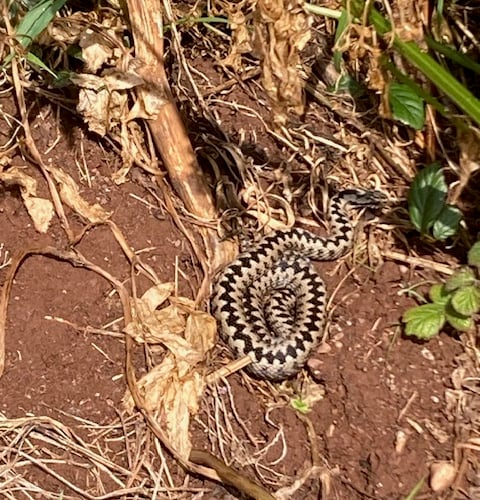Recent articles in the Newspaper about the dangers of Water Dropwort amused me at first, then alarmed me when I realised there might be a campaign to eliminate this attractive white-flowering plant from all the marshy ground around Totnes. Our nectar-loving insects have enough trouble finding food sources as it is, so many wild flowering plants having been eliminated by modern agricultural practices and a wish to keep our roadsides tidy. There is no doubt that Water Dropwort hemlock (Oenanthe crocata) is poisonous, but no more so than many other wild plants and fungi. Be aware, this isn’t the infamous hemlock species, Conium maculatum, whose root was used to poison Socrates or was added to the three witches’ brew in Macbeth. Although both hemlocks are white flowering umbellifers, the latter prefers a drier habitat to Water Dropwort.
This apparent desire to make the countryside safe to all, whatever their level of knowledge, got me thinking about the risks surrounding us when we walk in our beautiful countryside. It also got me thinking about the difference between perceived and actual risk. Famously, the greatest risk when taking a flight on a commercial aircraft is the road journey to the airport and not the flight itself.

So. what could be safer than a walk around Slapton’s Lower Ley? I have included a few photographs of some potential risks. Most you will almost certainly see; one is something you would be very lucky to see.
Of the three snakes native to England, only one is venomous - the adder- and even this is way down the world league table in terms of the toxicity of its venom. To compare this with two countries that Elaine and I visit most frequently: Italy has 20 native snakes, eight venomous; and Costa Rica 137, a great many venomous. Does this stop us walking in the Italian or Costa Rican countryside? No. But do we walk in sandals? No.

Unfortunately, adder numbers in England have declined sharply. Gordon Waterhouse says that 30 years ago they were common in Andrew’s Wood, but I have never seen one there in 20 years. We are lucky that they are still quite common around Slapton. My photograph of this beautiful basking male was taken this year by Mark, who lives here in the village. Some people are fearful of all snakes, but they shouldn’t be, especially in England. Even an adder offers a very small risk to a human, but don’t let your dog off its lead to poke its nose into the undergrowth as you walk down the coastal path on a summer’s day. An adder bite on the nose would really hurt, and probably entail a stiff vet’s bill, and it is the adder that has legal protection.
My next photograph shows what appears to be two paths ahead, but there is only one up the hill to the left. The other is a cut-through available when the water in the Ley is low. It heads over many, many exposed tree roots. Walking on tree roots can compact the ground and cause the death of the trees, but they are also a trip hazard if you don’t take great care. One of our near neighbours tripped here, grazed her arm and spent days in hospital with a serious blood infection.
My final two photographs show a view of the beach by the Ley, and water dropwort together with a yellow iris flowering by a boardwalk over the wet woodland. I would say they share one principal hazard - not the water dropwort, and not immediately visible. It is the raw sewage entering the Ley.
When the volume of sewage/rainwater entering Slapton’s Water Treatment Plant exceeds its capacity and overwhelms its emergency holding tank, raw sewage flows into the adjacent wet woodland, under, and sometimes over, the boardwalk. Last year, this problem was exacerbated by a structural failure of the Plant itself, now repaired, but it still becomes overwhelmed by intense rainfall.
Therefore, if your dog jumps into the muddy water by the boardwalk, which I know does occur, beware touching him/her with your bare hands. (The stench coming from the dog might alert you.) I also urge caution trying to wash the dog in the waters of the Ley itself. Frequently there are notices in the summer advising of the dangers of green algae, but who knows what else is present, having flowed via the streams into the Ley from the sewage works. Clearly the situation at Slapton is not unique. When James and I counted the water birds on Kingsbridge Estuary last month the foreshore was far from pristine. The health of our rivers and water courses is of widespread national concern.
In the countryside, there are natural hazards all around you, but with a little knowledge and common sense they are usually easy to avoid, especially in a country as benign as the UK. However, don’t just walk and talk. Keep your eyes open, and listen. It will keep you safer and you might just spot that kingfisher or otter you might otherwise have missed.


.jpg?width=209&height=140&crop=209:145,smart&quality=75)


